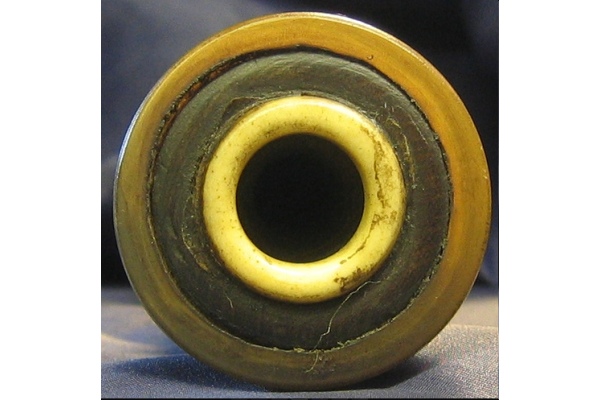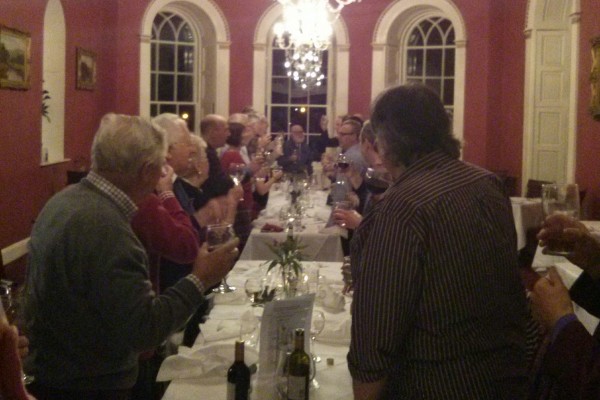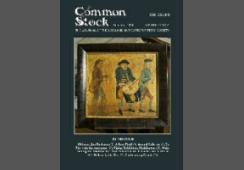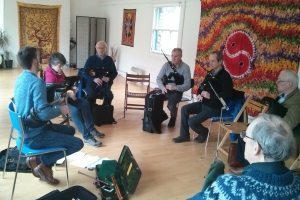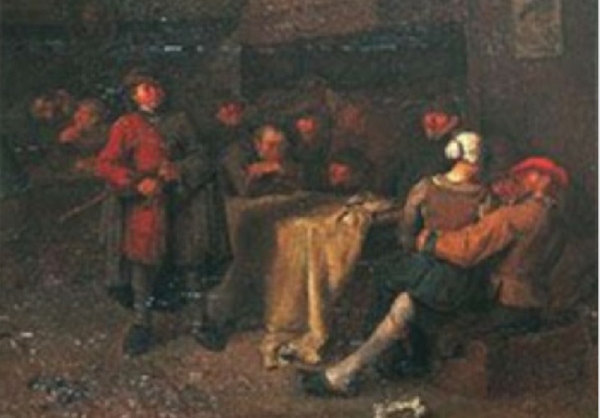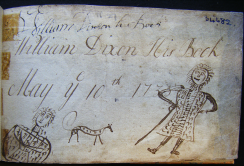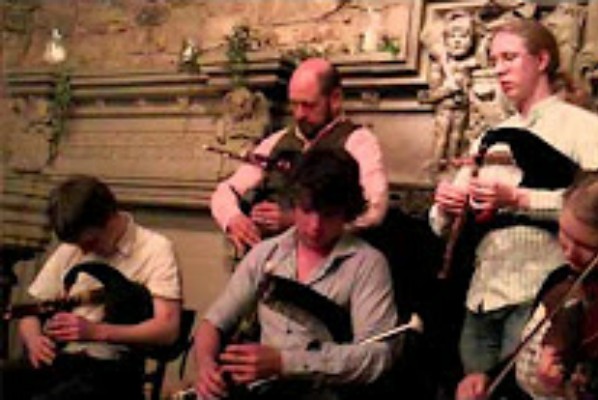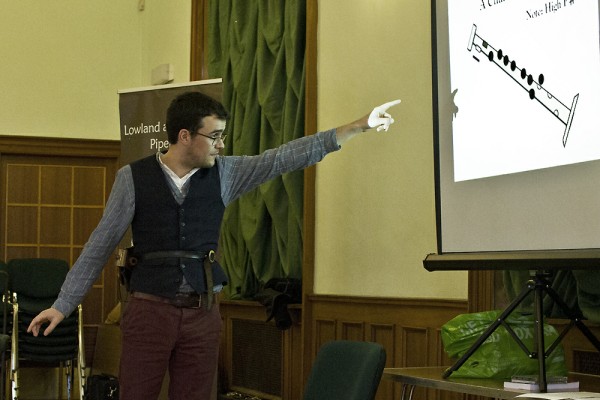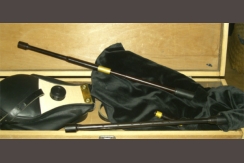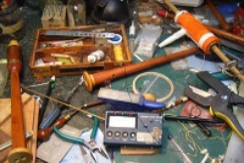by Susan King

Susan King: (photo by John Bushby)
It all began on a grey Paris morning in 2009 as I did my daily lute practice and thought about what had led me to move to the other side of the world from my home in Australia. It was music of course. I play the French Baroque Lute and a year before, I had left everything I knew in Australia to experience the music I loved in its native home.
There was also another reason for the journey, to find out where my family had come from. Left bereft by war, my grandmother emigrated to Australia with her two children. Our heritage is Scotland, the border areas of Hawick and we are of the Murray and MacDonald clans. I had recently stayed in Hawick. meeting members of my family and gaining a fuller understanding of my history.
So as I played my lute that morning, I wondered how I could reconcile these two aspects of myself. My love of the French lute and my Scottish heritage. I then thought of the Balcarres Lute Manuscript. I had a facsimile copy of it but I had never looked at it. It seemed to me that this would be the perfect project to bring the French and Scottish aspects of my life together.
I listened to all the recordings of the Balcarres that I could and found that up to that time they were all solo lute recordings. I felt that I wanted to do something more than this, that I wanted to understand the roots of the music in the Balcarres Lute Manuscript. It was obvious to me that if I wanted to do this I would need to collaborate with musicians who were experts in playing traditional Scottish music.
I instantly thought of John and Caroline Bushby and their son Malcolm, whom I knew from when they lived in Tasmania, and who were now living in Newcastle, UK. I contacted John, who was enthusiastic about the project, and so began the long journey from idea to finished
The first thing I did was start to transcribe the lute tablature that the manuscript is written in to modern notation, so that John and Caroline could read it.

Lute tablature from the Balcarres Manuscript
This was a long laborious task and I soon realised that I couldn’t expect to transcribe the entire manuscript as it would take far too long. I sent John what I had done but we could see that this wasn’t going to work.
So I visited Newcastle, and John and I sat around the table with the manuscript and selected pieces to try out. This was a true revelation. With John on his pipes and me on my lute we began to play through some of the tunes together. The first thing that amazed us was how the two instruments combined so well together. We had expected that the pipes would completely drown out the lute but the lute could be heard when they played together. It was a wonderful experience to bring these two instruments together.
By trying out pieces this way, we finally arrived at the music we wanted to do for the CD.
We then began the task of finding as many versions of each piece as we could and for songs, we looked for versions of the words that would probably have been known in the 17th century.
John had some useful books in his personal music library that we used as references, and of course there were internet and library resources we found that also proved invaluable.
Gradually we created versions based on the Balcarres Lute Manuscript and versions of the pieces we had found elsewhere, we also used John’s and Caroline’s knowledge of traditional music practice and my knowledge of French lute playing. Following is an example of the transition of one tune “The Lads of Gallowater” from lute tablature to notation.
That wasn’t the end of it though, for many of the tunes we then had to find a key that was compatible with a lute tuned to A = 415 and pipes in A = 440. In some cases this meant changing the key of the Balcarres version and remembering that John and I wouldn’t be playing the same note-name in order to achieve the same sound.
For example, with the lute at 415, if it played an F this would sound as an E, so in order to sound as F, the lute needed to play F#. We had many a moment when John and I were talking about notes only to realise that a misunderstanding had arisen because of the different pitches of our instruments.
For some of the pieces we could not find a way to match a suitable key for the pipes with something that was playable on lute. It was then that John devised the lute capo. This was a brilliant idea and a simple and effective solution to a difficult problem

‘The Bushby’ lute capo
Throughout our work on the Balcarres I often thought of why the manuscript was compiled and who may have done so. Official sources such as Matthew Spring’s Balcarres Lute Book (which came out whilst we were engaged in the CD project) can only state what is verified by the results of his research.
He states that the book was possibly written out by Margaret Campbell, the wife of Colin, third Earl of Balcarres. In the baroque era, the lute teacher or pupil or perhaps mother of a lute pupil would copy notes and music from the teacher’s book to the pupil’s book. This could be why the Balcarres Lute Manuscript appears to be in the hand of Margaret Campbell. Was she the student? Or the mother of the student? At this stage we do not know and can only assume that there was someone in the Earl of Balcarres' household having lute lessons from an unnamed lute teacher.
Mr Spring also provides some information on several of the Scottish composers who are named in the manuscript. One of these is a Mr Beck, who was an Edinburgh lute teacher. Was he the teacher sent to the Earl of Lindsay’s household to give lessons? We have no evidence to support this but perhaps it is possible that he was.
And so, as a lute teacher myself and not limited by the scholarly need to only state what can be verified with hard evidence, I allow myself to dream a little and imagine Mr Beck, my colleague from several hundred years ago, and what it would have been like to teach lute to a member of the Earl of Balcarres' household.
Mr Beck was known to have many friends firmly rooted in the musical life of that city. The music of Scotland would have been ‘in his bones’ and so, when called upon to teach lute, he naturally would have used the music that he knew and loved best as his inspiration.
Perhaps this is how the Balcarres Lute Manuscript came to be. Perhaps it is the work of a humble Edinburgh music teacher, work that many of you reading this article will also do. John, Caroline and myself have all been music teachers and so it is fitting that in recording this CD we not only seek the roots of the music in the Balcarres manuscript but honour the music teacher who was responsible for it, and all music teachers, who through their lessons enrich our lives so much.
So this is my side of the story of how we came to record the Balcarres Lute Manuscript. My final trip to John and Caroline’s home for recording was done from Australia with its 23 hour flight, all the time worrying about the delicate instrument in luggage and the dreaded jet-lag at the end of it all.
These were no ordinary recording sessions: there were differences in instruments, pitches and musical styles to be overcome. Finding a meeting ground between the rarefied world of French baroque lute and the traditional music of Scotland and England wasn’t always easy, but now that the task is complete we feel it has been very worthwhile. As always happens in musical collaborations we learned from each other and went away from it enriched. It is now time to share our experiences with everyone as the CD is launched. We hope you enjoy it.John continues:
When Susan suggested to us that we should do this project, Caroline and I leapt at the chance as it enabled us to indulge in our love of Baroque music and also of Scottish and traditional music. With our own strong Scottish family backgrounds, (in my case Douglas, Gordon, Matheson, Gunn, Fraser and McDonald, and Caroline’s family were Beiths from Ayrshire), the idea of combining everything was one we couldn’t resist.
It has been an interesting experience doing a recording with us being 12,000 miles apart. With today’s technology it is amazing what can be achieved.
As for the pipes, in the main we have used the D or C smallpipes as these are closer in pitch to the pipes of the era. However we have also used the modern A smallpipes and the Lowland/Border pipes. There is also one track that uses the Irish or Uilleann pipes.
Why the name The Lomond Ensemble? The name links both Scotland and Tasmania and also our collective family heritages. In north east Tasmania there is a mountain called Ben Lomond, after the Scottish mountain of the same name. Tasmania (Van Dieman’s Land) had very strong links to Scotland. One of its early Governors was Lachlan Macquarie from the island of Ulva, and he named many places after his own homeland. Not only that, two thirds or thereabouts of all Scottish immigrants in the mid 1800s to Australia, including my own, ended up in Tasmania. That link was maintained by many Caledonian societies throughout the island state, every region had one or more pipe bands, and there was also the Church of Scotland and even a Caledonian Football Club when I was growing up! Australia’s first Gaelic newspaper (Gaelic was Australia’s second official language), though short lived, was published in Hobart, Tasmania in the early 1800’s.
There is a lot more I could talk about but it is outside the remit of this article. Suffice to say that in the late 1980s Caroline and I were busking at a local market – I was playing Northumbrian smallpipes – and we were approached by an onlooker who said “I have a set of pipes like that at home”. So my pipe maker and good friend Malcolm McLaren (also a member of the LBPS), and I went along and found not Northumbrian pipes but an old set of Border/Lowland pipes. We were amazed. I have no idea why we didn’t take photos and goodness knows what ever happened to them, the owners didn’t appear to want to part with them. So not only were there Highland pipes being played in Tasmania but also at some stage there were bellow pipes being used. Around the same time a very old set of Irish pipes was unearthed as well.
Thanks to the generosity of the Lowland and Border Pipers Society, via their grants programme, we were able to make the project come to a conclusion in the production of The Lomond Ensemble CD.

John Bushby, Malcolm Bushby, Susan King and Caroline Bushby
The CD ‘The Lass of Pettie’s Mill’ is available from the LBPS online shop
